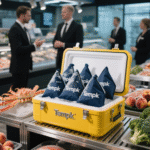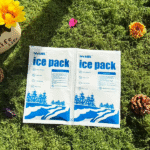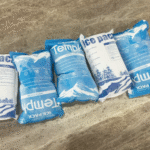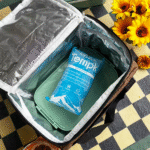Kotak Dryicepack Untuk Makan Siang: Bagaimana Anda menjaga makanan beku sampai jam 3 sore?
Packing a dry ice pack for lunch box sounds tempting when standard gel packs turn lukewarm by noon. Before you pop –78 °C into a school bag, let’s review safety, optimal pack size, and 2025‑ready insulation that keeps food safe—without frostbite or soggy sandwiches.
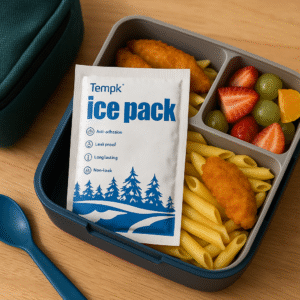
-
How small can a dry ice pack be and still work in a lunch box?
-
Which venting and liner tricks prevent CO₂ build‑up in tight spaces?
-
Smart hybrid coolants that pair micro dry ice with gel for mixed meals
-
2025 regulations for sending dry‑ice lunches to workplaces or camps
-
Eco‑friendly disposal and pack‑refill hacks to cut waste
Is Dry Ice Even Safe Inside a Lunch Box?
Dry ice sublimates to CO₂ gas; without a vent it can pressurize a sealed container and blast lids off. Skin contact at –78 °C freezes tissue in < 5 detik. Yang mengatakan, using a palm‑sized, insulated dry‑ice sheet (< 100 g) with a micro‑vent slot can hold sub‑4 °C for four hours—perfect for sushi or yogurt parfaits—when handled correctly.
Mini Dry Ice Load Chart for Lunch Boxes
| Lunch Type | Food Weight | Dry Ice Needed | Tahan waktu | Vent Slot |
|---|---|---|---|---|
| Bento (600 G) | 0.6 kg | 60 G | 4 H | 2 mm |
| Salad + Protein (800 G) | 0.8 kg | 80 G | 4.5 H | 3 mm |
| Ice‑cream cup (100 G) | 0.1 kg | 40 G | 3 H | 2 mm |
Matematika Cepat: target 10 % of food weight in dry ice for a four‑hour school window.
Packing a Lunch Box with Micro Dry Ice Packs Safely
-
High‑R reflective pouch lines the interior.
-
Tempat gel pack (0 ° C.) at the bottom—shields delicate produce from deep freeze.
-
Add food containers—ensure lids are sealed.
-
Corrugated spacer di atas.
-
Lay the micro dry‑ice sheet above spacer, vents facing zipper gap.
-
Zip bag loosely, leaving a 2–3 mm gap for gas escape.
H3: Best Lunch‑Box Liners for Dry Ice Cooling
| Liner Type | R‑Value | Berat | Keuntungan |
|---|---|---|---|
| Mylar Bubble | 4.0 | 40 G | Ringan, reflective |
| Fold‑Flat Aerogel | 5.5 | 60 G | Thinnest high‑insulate option |
| PCM‑Infused Fabric | 3.5 | 55 G | Gradual temp buffering |
Hands‑On Tips
-
Work commute: Slip a 60 g dry‑ice card in a vented coffee thermos pocket—keeps smoothies chilled to 2 °C until mid‑morning break.
-
Summer camp: Combine 80 g dry ice with a sweat‑proof gel pack; teach kids to leave the lid slightly ajar.
-
Picnic prep: Pre‑cool the lunch box in a freezer for 30 minutes—extends chill window by ~15 %.
Kasus nyata: A tech firm’s cafeteria issued 90 g dry‑ice inserts for employee bento boxes; lunchtime audits showed internal temps under 5 °C after four hours, with zero blister incidents.
When to Skip Dry Ice and Use Hybrid Coolants
| Skenario | Tingkat Risiko | Recommended Coolant |
|---|---|---|
| Toddlers’ soft lunch bags | Tinggi | 0 Datang ° C. + PCM wrap |
| Air travel carry‑on | Sedang | ≤2.5 kg dry ice in vented cooler (follow TSA rules) |
| Outdoor job sites >35 ° C. | Rendah | 10 % dry ice + gel combo |
2025 Regulations and Environmental Notes
-
School policies: Many districts ban dry ice unless stored in vented hard‑shell containers—check your handbook.
-
Workplace shipping: Label “UN 1845 DRY ICE, bahan makanan, < 100 g” for campus courier safety.
-
Eco‑swap: Carbon‑negative dry ice from brewery CO₂ plus LDPE pack sleeves recycled via #4 stream.
FAQ
Can dry ice explode a plastic lunch box?
Ya, if the lid is airtight. Always leave a 2–3 mm vent gap.
Will CO₂ make my food taste fizzy?
TIDAK. Gas dissipates quickly and does not dissolve into sealed containers.
How do I dispose of leftover dry ice at school?
Place it on a metal tray in a well‑ventilated area until it fully sublimates; never in the sink.
Ringkasan & Rekomendasi
A dry ice pack for lunch box works when you limit weight to ~10 % of food mass, add a gel buffer, and vent the lid. Follow the six‑step packing order above to keep meals below 5 °C through lunchtime—safely and sustainably.
Langkah selanjutnya:
-
Order palm‑sized dry‑ice sheets and reflective liners.
-
Train users on venting and touch‑free removal.
-
Test your packed lunch temp with an NFC sticker for data‑driven tweaks.
Tentang Tempk
Tempk engineers recyclable cold‑chain gear for cargo and personal meal prep. Our Micro‑Freeze™ sheet (40 G) maintains 0–4 °C for four hours in standard lunch boxes and fully sublimates before disposal time.
Need a custom lunch‑cooling kit? Pesan konsultasi gratis.
















